
(Click here for more pictures of the ball)
| A visit to
Vienna for the New Year's Eve Kaiserball at the
Hofburg Palace gave the opportunity for some visits to some
interesting producers.
(Click here for more pictures of the ball) |
![]()
An evening visit on 29th December 2001 to Schloss Gobelsburg at Langenlois in the Kamptal was a great start. We enjoyed a tasting of Gobelsburg and Bründlmayer wines over a splendid dinner.
You can reach the Gobelsburg website by following this link. The Schloss in its current form dates back to the early 18th century, though the history of the estate goes back several hundred years before that. Since 1740, Schloss Gobelsburg has been owned by the Cistercian monks of the Stift Zwettel, from whom Michael and Eva Moosbrugger lease the Schloss and vineyards, in collaboration with Willi Bründlmayer.
Michael Moosbrugger has a low intervention policy and to avoid disturbance by pumping, he has developed an unusual system for moving wine around his cellars - some of the barrels are on wheels. This also means that to help remove tartaric acid, they can just wheel the barrels outside when it's cold! The majority of the vineyards are planted with Riesling or Grüner Veltliner, with a bit of Pinot Noir and also some Blauburgunder, Merlot, Zweigelt and St Laurent. The main vineyards are the Zöbinger Heiligenstein, the Kammerner Gaisberg, Kammerner Lamm (aka Ried Lamm), Kammerner Grub (aka Ried Grub), Kammerner Renner and the Gobelsburger Steinsetz.
The Gaisberg and Heiligenstein are south facing, steeply terraced vineyards, facing the plain and the confluence of the rivers Kamp and Danube.
The original name for the "Heiligenstein" meant "hell's rock", though the current form of the name means "rock of saints", either reflecting the venerable wines originating here or the monks' ownership... The earlier meaning/form of the name may be more appropriate as it is a a cone of rock which has emerged through the surrounding area and it gets particularly hot in summer, as the the top soil consists of weathered crystalline rock, volcanic and desert sands that store the heat. The soils also provide a fine mixture of minerals to the vines. The Heiligenstein is Gobelsburg's best vineyard and is planted mainly with Riesling, and the increasing acreage of Pinot Noir.
The terroir of the Gaisberg, which is all planted with Riesling, is Gfoehl gneiss with vertical mica-schist structures. The soil is rougher and poorer than on the Heiligenstein and the resulting wines a little less minerally.
The other vineyards are predominantly planted with Grüner Veltliner:
The Rieden Lamm and Grub have a very deep loess soil deposited in the last ice age.
Ried Grub is the hollow between Heiligenstein and Gaisberg. Ried Lamm is a gentle south-facing slope, at the foot of the Heiligenstein
The Renner vineyard is in the shelter of the Gaisberg hill, with its own microclimate, protected from the worst of the cold and wind. The soil is loam and loess with sand from Waldviertel gneiss in places.
The Steinsetz vineyard is on an plain south of the Schloss. The terroir is based upon alpine pebbles and covered by black and loamy soil, loess and gravel.
|
After a tour of the cellars, where we were able to "admire" the barrels on wheels and see some of the dust encrusted ancient bottles that the monks still store there, we tried the Gobelsburg Brut Reserve fizz in the Moosbrugger's relatively newly established vinothek. Schloss Gobelsburg Brut Reserve Full flavoured. Quite upfront. Very firm mousse. Clean, quite big and full flavoured without too much acid. Very good length. Very impressive indeed.
|
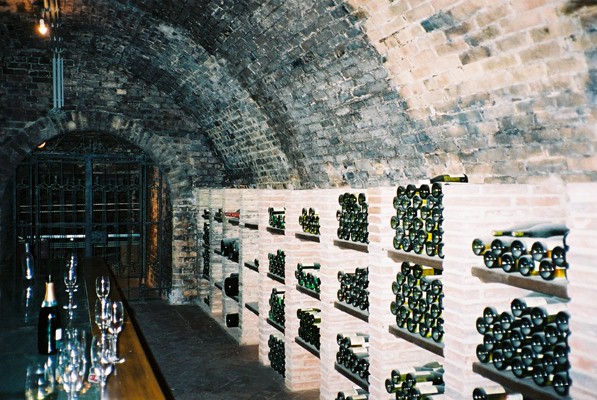 |
|
After the Brut Reserve we repaired to the Schloss itself and the former monks' refectory where we very much enjoyed a dinner of pumpkin soup, drizzled with pumpkin seed oil, followed by fabulous roast goose (about half a goose each!) and cherry strudel made with cherries grown in Gobelsburg's own orchards. Over dinner we tasted the following wines in pairs as indicated: |
||
|
Gobelsburg Ried Steinsetz
Grüner
Veltliner 2000 12.5% |
Bründlmayer,
Ried Vogelsang, Langenloiser Berg, Grüner Veltliner
2000 12% More complex nose. Slightly fuller. Distinctly less fruit, but more complex |

|
|
Gobelsburg Ried Grub, Grüner Veltliner 2000 14% Full, slightly rich nose. Clean attack. Fills a lot - very full and quite fat. Possibly just a little disappointing in that it doesn't live up to the expectation raised by the nose and attack. Fermented in steel and matured in large oak barrels for 5-6 months. Really needs to be kept a few years. Fair bit of residual sugar on the finish. |
Unfortunately the bottles of the Bründlmayer Ried Käferberg, Grüner Veltliner 2000 that were supposed to be paired with the Gobelsburger Ried Grub were below par and not served. | |
|
Gobelsburg Ried Lamm, Grüner Veltliner 2000 Like the Ried Grub, matured in large oak casks for 5-6 months. Slightly fragrant nose, if a bit flat. Good depth and character. Clean & fresh. Fills well and becomes rich and round. Very clean throughout with character. Rather good. |
Bründlmayer,
Ried Lamm, Grüner Veltliner 2000 Much fuller nose than the Gobelsburg Lamm. Big fat legs. Less fragrant, but a much more serious impression. Very impressive attack. Rich and full though perhaps just a little plasticky especially towards the finish. |
|
|
Gobelsburg Ried Gaisberg, Riesling 2000
12.5% Fermented and matured in steel only. Most unusual nose for a Riesling (unfortunately I've not written down what made it unusual ). Lovely attack. Doesn't fill much, but a gorgeous medium weight Riesling with a nice light acidity. |
Bründlmayer,
Ried Steinmassl, Riesling 2000 Very flat nose (but served rather warm). Lower acidity, slightly fuller, but lacks the elegance of the Gobelsburger Gaisberg. |
|
|
Gobelsburg Ried Heiligenstein, Riesling 2000 Full rich nose, rather lacking in fruit. Rather splendid attack. Rich and full. Some acid which comes through on finish. Good, and perhaps not showing at its best. |
Bründlmayer Ried Heiligenstein, Riesling 2000 Pleasant and fragrant. Clean, fairly fresh and light-ish. Pales beside the Gobelsburg. |
|
|
Gobelsburg Riesling Alte Reben 2000 (Geisberg) Some uncertainty as to the age of the "old vines", except that the monks, from whom Schloss Gobelsburg is now leased, know they were there in around 1958. Rather nice, more clearly Riesling nose. Fairly full attack. Clean, but full and rather rich. Slightly muddy on finish. |
Bründlmayer Riesling Alte Reben 2000 (Heiligenstein) Very rich nose. Full on attack, then actually appears to reduce a little in the mouth as a bit of acid kicks in. Good. Quite heavy and rich. |
|
|
Gobelsburg Pinot Noir 1996 (from magnum) (Heiligenstein) Lovely earthy, mushroomy Pinot Noir nose with soft cherry fruit in the background. Good attack. Smooth and remarkably rich and satisfying. Quite earthy on palate. Nice length. |
Bründlmayer Cuvée Cecile, Pinot Noir 1999 Much more closed nose. More forward fruit on palate. Appears much simpler than the Gobelsburg, though that does have a few years' advantage. |
|
|
Gobelsburg Trockenbeerenauslese 1998 Ried Heiligenstein Lovely honeyed nose. Excellent, bright attack. Rich and intense. Sweet but not at all cloying. Very nice acidity. We had the last bottles of this that the Schloss had available (other, presumably, than in the Moosbruggers' private vinothek). |
||
| Gobelsburg
Zöbinger Heiligenstein
Beerenauslese 1998 Again a lovely nose. Bit less intense than the TBA (naturally!). Remarkably fresh and fruity, with plenty of pleasing acidity. |
||
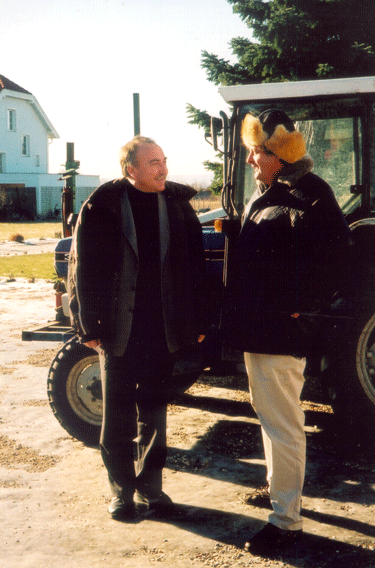 |
An entertaining afternoon of the 30th December 2001 was spent in Illmitz on the Neusiedlersee with the only ever so slightly mad, supreme self-publicist and extremely engaging Willi Opitz. Willi Opitz is a man of huge energy, ethusiasm and marketing skill, who strives to innovate. And for the most part he is successful. He doesn't do things the easy way and a spirit of adventure is definitely required of visitors and those tasting his wines. All the wines are made in relatively small quantities: he has just 8 hectares of vines, comprising Bouvier, Scheurebe, Zweigelt, Welschriesling, Sämling 88, St.Laurent, Muskat Ottonel and Pinot Noir. He does make some remarkably palatable dry tables wines and an attractive fizz, but his real strength is in dessert wines. The range encompasses Late Harvest, Beerenauslese and Trockenbeerenauslese wines, Eiswein and Schilfwein, where the grapes are dried on mats of reed taken from the nearby Neusiedlersee. Schilfwein required a change to Austrian winemaking law! Dessert wines are not just made from white grapes: the signature wine (literally so: bottles are individually autographed!), Opitz One, is a trockenbeerenauslese made from the singularly Austrian red grape, Zweigelt. Grappas, perhaps from an Eiswein are produced, and there is now even a sherry-like wine, Homok. There is even a Kid's Wine - grape juice! The location, on the shores of the huge steppe lake, the Neusiedlersee, stretching from Austria in Hungary, is a key element in the formation of Willi's dessert wines. The lake is very shallow (were it not for the mud, it would be possible to wade across), and creates the ideal conditions for noble rot (botrytis cinerea) to form on grapes. One of the most curious products - and probably the most curious product of any winery anywhere in the world is his CD The Sound of Wine, on which you can hear the sounds of different grape varieties fermenting in his winery. It seems flippant and bizarre, but from the proceeds, Willi Opitz has bought at least one tractor.
|
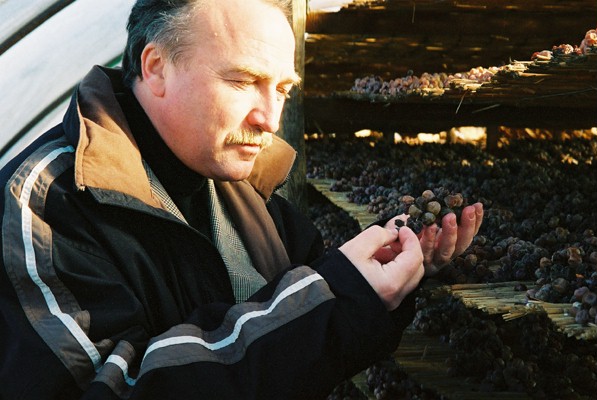
|
|
We started in the winery with a glass of pink fizz, before moving onto a number of wines produced by the jug-full from the surrounding barrels. Willi Opitz Rosé
Madame (sold under
the label Fizzy Willy in the
UK) Willi Opitz Barrel sample -
Welschriesling
Qualitätswein 2001 Willi Opitz Barrel sample -
Silver Lake
Spätleses 2001 Willi Opitz Barrel sample -
Zweigelt 2001 Willi Opitz Barrel sample - St
Laurent 2001 |
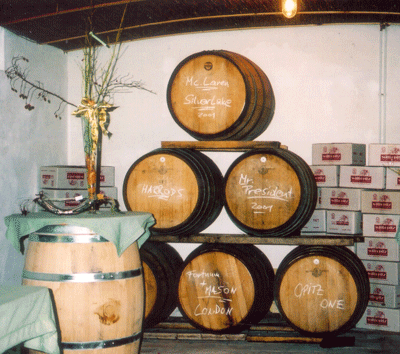 |
|
Moving indoors, we had an Opitz food and wine matching ... umm ... experience.
Willi Opitz McLaren Pole Position Bouvier 2001
10.5% €5.80
Willi Opitz Muskat Ottonel 2000 €8.70
Willi Opitz Silver Lake 2000 €13.70
Willi Opitz "Rotschenkel" Zweigelt Reserve
2000 €13.70
Willi Opitz Welschriesling Eiswein
1998 €23.60
Willi Opitz Opitz One 1997
€30.20
Willi Opitz Goldackerl Scheurebe
Trockenbeerenauslese 1998 €26.20
The
following wines were tasted in London on 19th May
2005:
2004 St Laurent 2003 Pinot Noir 2004 Merlot
|
|
Vienna is the only capital city in Europe which has important vineyards within its city limits: around 620 hectares in fact. Soils vary enormously from one site to the next and even within the same vineyard, and the quality of the wines produced can also be very variable. Some producers are well respected, but most of the wine grown in Vienna is fairly low quality, designed to be drunk in quantity at the Heurige, or wine bars, in the outskirts of Vienna: there are about 30 of them, plus many more in more outlying areas and the Thermen region. The bars serve Heurige wines from 11 November onwards. Heurige wines are new wines from the same year and are served for a period of 300 days, after which the wine is no longer regarded as a Heuriger. Weingut Christ's main vineyards are on the gently sloping south-facing Bisamberg Hill, on the north-eastern boundary of the Vienna. Apparently, the Bisamberg is the most easterly mountain of the Alps. And it is where most of Vienna's vines grow. A wide range of grape varieties are planted, though as you can see GrüV dominates: |
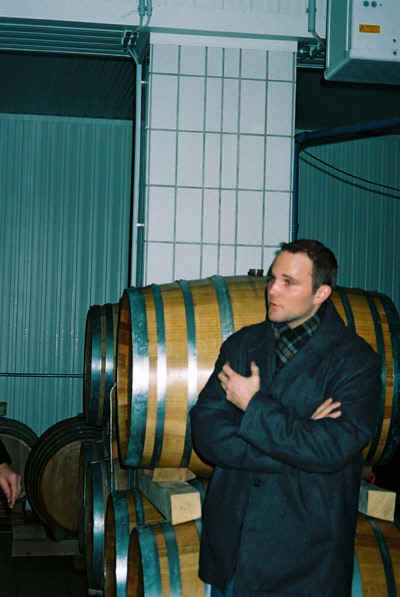
|
Grapes for white wine
Grapes for red wine
The winery is based in Jedlersdorf and was completely refurbished in 1995. Now all very modern and hygienic with temperature control. For the winemaking, stainless steel, large casks and oak barriques are all used.
Weingut Christ 2001 Grüner
Veltliner Bisamberg
A typical Viennese Heurige wine, made for immediate consumption. It has
a very attractive
nose - light and spicy with a hint of apple. Very light and very fresh
on the palate, with lots of
fruit. Fairly simple, but quite attractive. Good.
Weingut Christ 2001 Gelber Muskateller trocken
Rather subdued muscat nose. Full on attack. Fairly rich and round, yet
also clean and fresh. Again fairly
simple. Good.
Weingut Christ 2000 Grüner Veltliner "Bruch"
A rather closed nose, but fairly rich. Clean and crisp on the attack.
It then fills very well on the palate.
Fairly rich. Excellent length with a nice spiciness after. Remarkable
length. Very Good.
Weingut Christ 2000 Weissburgunder "Der
Vollmondwein"
trocken
Christ's Pinot blanc comes from a relatively high part of the
Bisamberg,
specifically the Ried Falkenberg.
Quite a "pale" nose - seems slightly oaked. Hefty legs. Fairly full
attack. Good body. Full, clean and quite impressive. Very
Good Indeed.
The information sheet says that around 25% of the wine was vinified in
French
oak
Weingut Christ 2000 Blauer Zweigelt
When I tasted this, it had been in bottle only about a month, after 10
months in used barrique and a further 2
months in large barrels. The grapes had come from two separate
vineyards, one with 15 year old Zweigelt vines, the other with 40 year
old vines.
It has a soft, cherry nose with a sweetness to it - almost a
hint of white chocolate. Very soft, lots of fruit. Fairly simple and
perhaps a
little young, but no great life ahead of it. (Rainer Christ said he
thought it would need drinking within five years at the very
most.) Pleasing, soft tannins on
finish. Very Good.
Weingut Christ 2000 Cuvee Mephisto
A barrel sample of a blend of 70% Zweigelt (from vines over 40 years
old), 15% Cabernet Sauvignon, 15%
Blauburgunder. This has another 12-14 months in 100% new barriques to
go yet.
A dark and inky appearance and very big on the nose.
Already, this is very full on the attack. On the palate, it's very
smooth and is already enormously rich with
great depth. Very hefty tannins apparent on finish. Could be moderately
interesting when it's ready. Very Good.
Weingut Christ 1999 Or Liquide
A Beerenauslese made from the distinctly un-Austrian combination of
Pinot Blanc,
Chardonnay, Sauvignon Blanc and Riesling in equal proportions.
This has a very complex
nose redolent of mango, honey and raisins. Fine attack - quite
luscious. Very clean and
fresh. The acidity isn't especially high - there's just a hint, but I
think it gets away with it. Rather good - has quite a bit
of interest to it. Very Good Indeed.
At the Kaiserball in the Hofburg Palace on 31st December 2001 (and on 1st January 2002) we had the following with the meal and at midnight. I did not take tasting notes, or even note the vintages:
At other meals, we had the following (again no notes or even vintages!)
And a couple tasted more recently:
1999
Zöbinger Heiligstein Riesling,
Schloß Gobelsburg
Greenish gold. Very slight nose with a hint of fragrance - after time
the nose
develops a waxy lime character. Fresh and clean on attack with notable
acidity.
Fills well and quite full and rich on palate. Nice clean finish, with
the same
acid running through.
1998
"Pinot Cuvée" Ruster Ausbruch,
Feiler-Artinger
A luscious copper gold. Intense honeyed nose with raisins and dried
figs.
Lavish, very sweet attack reminiscent of liquid raisins with raw cane
sugar and
molten gold (not that I've drunk gold - not other than Goldwasser, that
is).
Very intense. Very sweet, but with a welcome touch of acid on the
finish.
Ultimately perhaps rather unidimensional, but it's a jolly hedonistic
dimension
that it's on.
1999
Gruner Veltliner Eiswein Schloss Gobelsburg
Medium gold. Unusual nose. Very intense, very elegant. But a bit odd,
like
scented wet grass with vanilla, lemongrass and lime. Explosive attack.
Fresh and
intense and almost alarmingly mouthfilling as it develops in the mouth.
Very
very clean and elegant - there's a fairly powerful acidity keeping it
in
excellent balance. Finishes with honeyed essence.
![]()
Back to Andrew Stevenson's web page
Last updated: 15 December 2005 12:40